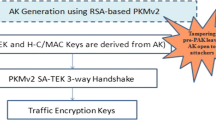Abstract
Authentication per frame and symmetric key based encryption is an implicit necessity for security in Wireless Local Area Networks (LANs). We propose a novel symmetric key based secure WLAN communication scheme. The scheme provides authentication per frame, generates new secret key for encryption of each frame and involves less message exchanges for maintaining the freshness of key and initial vector (IV). It enhances wireless security by utilizing key hiding concept for sharing the symmetric secret key and IV. The shared secret encryption key and IV are protected using counters and then mixed with each other before sending. We prove security of the scheme in Canetti–Krawczyk model.





Similar content being viewed by others
References
Kothmayr, T., Schmitt, C., Hu, W., Brunig, M., & Carle, G. (2013). DTLS based security and two-way authentication for the Internet of things. Ad Hoc Networks, 11, 2710–2723.
Johnson, H., Nilsson, A., Fu, J., Wu, S.F., Chen, A., & Huang, H. (2002). SOLA: A one bit identity authentication protocol for access control in IEEE 802.11. In Proceedings of IEEE global telecommunications conference, GLOBECOM’02 (pp. 768–772).
Wu, F., Jonson, H., & Nilson, A. (2004). SOLA: Lightweight security for access control in IEEE 802.11, wireless, security, 10–16 May/June 2004.
Wang, H., Velayutham, A., & Guan, Y. (2003). A lightweight authentication protocol for access control in IEEE 802.11. In Proceedings of IEEE global telecommunications conference, GLOBECOM’03 (pp. 1384–1388).
Wang, H., Cardo, J., & Guan, Y. (2005). Shepherd: A lightweight statistical authentication protocol for access control in wireless LANs. Computer Communications, 28, 1618–1630.
Ren, K., Lee, H., Park, J., & Kim, K. (2004). An enhanced lightweight authentication protocol for access control in wireless LANs. In Proceedings of 4th international conference on networks, ICON’04 (pp. 444–450). South Korea: Daejeon.
Lee, Y.-S., Chien, H.-T., & Tsai, W.-N. (2009). Using random bit authentication to defend IEEE 802.11 DoS attacks. Journal of Information Science and Engineering, 25, 1485–1500.
Pepyne, D.L., Ho, Y-C., & Zheng, Q. (2003). SPRiNG: Synchronized random numbers for wireless security. In Proceedings of IEEE wireless communications and networking, WCNC’03 (pp. 2027–2032).
Lee, I., & Hunt, R. (2010). A novel design and implementation of dos resistant authentication and seamless handoff scheme for enterprise WLANs. Proceedings of Australian information Sec. Management (pp. 49–61). Perth Western Australia: Edith Cowan University.
IEEE 802.11i., (2004). Wireless LAN medium access control (MAC) and physical layer (PHY) specifications: Medium access Control (MAC) security enhancements, IEEE Standard.
Li, X., Bao, F., Li, S., & Ma, J. (2013). FLAP: An efficient WLAN initial access authentication protocol. IEEE Transactions on Parallel and Distributed Systems, 99, 1–11.
Singh, R., & Sharma, T. P. (2013). A secure WLAN authentication scheme. IEEK Transaction on Smart Processing and Computing, 2(3), 176–187.
Martinovic, I., Zdarsky, F. A., Bachorek, A., & Schmitt, J. B. (2007). Measurement and analysis of handover latencies in IEEE 802.11i secured networks. In Proceedings of the European wireless conference (EW2007), (pp. 1–7). Paris.
Martinovic, I., Zdarsky, F. A., Bachorek, A., & Schmitt, J. B. (2006). Introduction of IEEE 802.11i and measuring its Sec. vs. performance tradeoff. Technical Report 351/06. University of Kaiserslautern, Germany.
Martinovic, I., Zdarsky, F. A., & Schmitt, J. B. (2006). On the way to IEEE 802.11 DoS Resilience. In Proceedings of IFIP NETWORKING, workshop on security and privacy in mobile and wireless networking, Coimbra, Portugal, Springer LNCS.
He, C., & Mitchell, J. C. (October 2004). Analysis of the 802.11i 4-way handshake. In ACM workshop on wireless, security, (WiSe’04) (pp. 43–50).
He, C., & Mitchell, J. C. (2005). Security analysis and improvements for IEEE 802.11i. In Proceedings of the annual network and distributed system security symposium (NDSS’05) (pp. 90–110).
Park, C. S. (2010). Two-way handshake protocol for improved security in IEEE 802.11 wireless LANs. Computer Communications, 33(9), 1133–1140.
Rango, F. D., Lentini, D. C., & Marano, S. (2006). Static and dynamic 4-way handshake solutions to avoid denial of service attack in Wi-Fi protected access and IEEE 802.11i. Journal on Wireless Communication and Network, 2006, 1–19.
Wang, L., & Srinivasan, B. (2010). Analysis and improvements over DoS attacks against IEEE 802.11i standard. In IEEE international conference on network security, wireless communications and trusted computing (pp. 109–113). China.
Martinovic, I., Pichota, P., Wilhelm, M., Zdarsky, F. A., & Schmitt, J. B. (2008). Design, implementation, and performance analysis of discosec: service pack for securing WLANs. In WOWMOM (pp. 1–10).
Arbaugh, W. A., Shankar, N., Wang, J., & Zhang, K. (2002). Your 802.11 network has no clothes. IEEE Wireless Communication Magazine, 9, 44–51.
Bittau, A., Handley, M., & Lackey, J. (2006). The final nail in WEP’s coffin. In Proceedings of the IEEE symposium on security and privacy, (S &P’ 06) (pp. 386–400).
Tews, E., Weinmann, R., & Pyshkin A. (2007). Breaking 104 bit WEP in less than 60 seconds. In Proceedings of international conference on information security applications, WISA (pp. 188–202).
Holt, A., & Huang, C. Y. (2010). 802.11 Wireless networks: Security and analysis. Berlin: Springer.
Helena, R.-P., & Jordi, H.-J. (2011). Computational and energy costs of cryptographic algorithms on handheld devices. Journal Future Internet, 3, 31–48.
Komarova, M., Riguidel, M., & Hecker, A. (2007). Fast re-authentication protocol for inter-domain roaming. In Annual IEEE international symposium on personal, indoor and mobile radio communication (PIMRC’07), Athens, Greece.
Bellare, M., Canetti, R., & Krawczyk, H. (1998). A modular approach to design and analysis of authentication and key exchange protocols. In Proceedings of the thirtieth annual ACM symposium on theory of computing, STOC ’98 (pp. 419–428).
Canetti, R., & Krawczyk, H. (2001). Analysis of key-exchange protocols and their use for buliding secure channels. In B. Pfitzmann (Ed.), Advances in cryptology-eurocrypt (pp. 453–474). Berlin: Springer.
Canetti, R., & Krawczyk, H. (2001). Analysis of key-exchange protocols and their use for buliding secure channels (Full version). http://eprint.iacr.org/2001/040.
Author information
Authors and Affiliations
Corresponding author
Rights and permissions
About this article
Cite this article
Singh, R., Sharma, T.P. A Key Hiding Communication Scheme for Enhancing the Wireless LAN Security. Wireless Pers Commun 77, 1145–1165 (2014). https://doi.org/10.1007/s11277-013-1559-0
Published:
Issue Date:
DOI: https://doi.org/10.1007/s11277-013-1559-0




